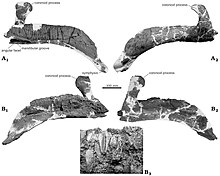Sahaliyania
|
Sahaliyania Temporal range: Late Cretaceous, 68–66 Ma |
|
|---|---|
 |
|
| Lower jaws and teeth | |
| Scientific classification | |
| Kingdom: | Animalia |
| Phylum: | Chordata |
| Class: | Reptilia |
| Clade: | Dinosauria |
| Order: | †Ornithischia |
| Suborder: | †Ornithopoda |
| Family: | †Hadrosauridae |
| Tribe: | †Lambeosaurini |
| Genus: |
†Sahaliyania Godefroit et al., 2008 |
| Type species | |
|
†Sahaliyania elunchunorum Godefroit et al., 2008 |
|
Sahaliyania (from "black" in Manchu, a reference to the Amur/Heilongjiang River) is a genus of lambeosaurine hadrosaurid dinosaur (crested duckbilled dinosaur) from the Late Cretaceous of Heilongjiang, China. Its remains were found in a bonebed in the Maastrichtian-age Yuliangze Formation, alongside rarer remains of the hadrosaurine hadrosaurid (flat-headed duckbill) Wulagasaurus. Sahaliyania was named by Pascal Godefroit and colleagues in 2008. It is one of several hadrosaurids from the Amur River region named since 2000. The type and only species to date is S. elunchunorum, named in honor of the Elunchun people.
Sahaliyania is based on GMH W453, a partial skull. Godefroit and colleagues assigned numerous other fossils from the bonebed to their new genus, representing much of the skull, pectoral girdle, upper arm, and pelvis. It can be distinguished from other hadrosaurids by a variety of anatomical details. Godefroit and colleagues performed a phylogenetic analysis that places Sahaliyania as a lambeosaurine of uncertain relationships. As a hadrosaurid, Sahaliyania would have been an herbivore.
...
Wikipedia
